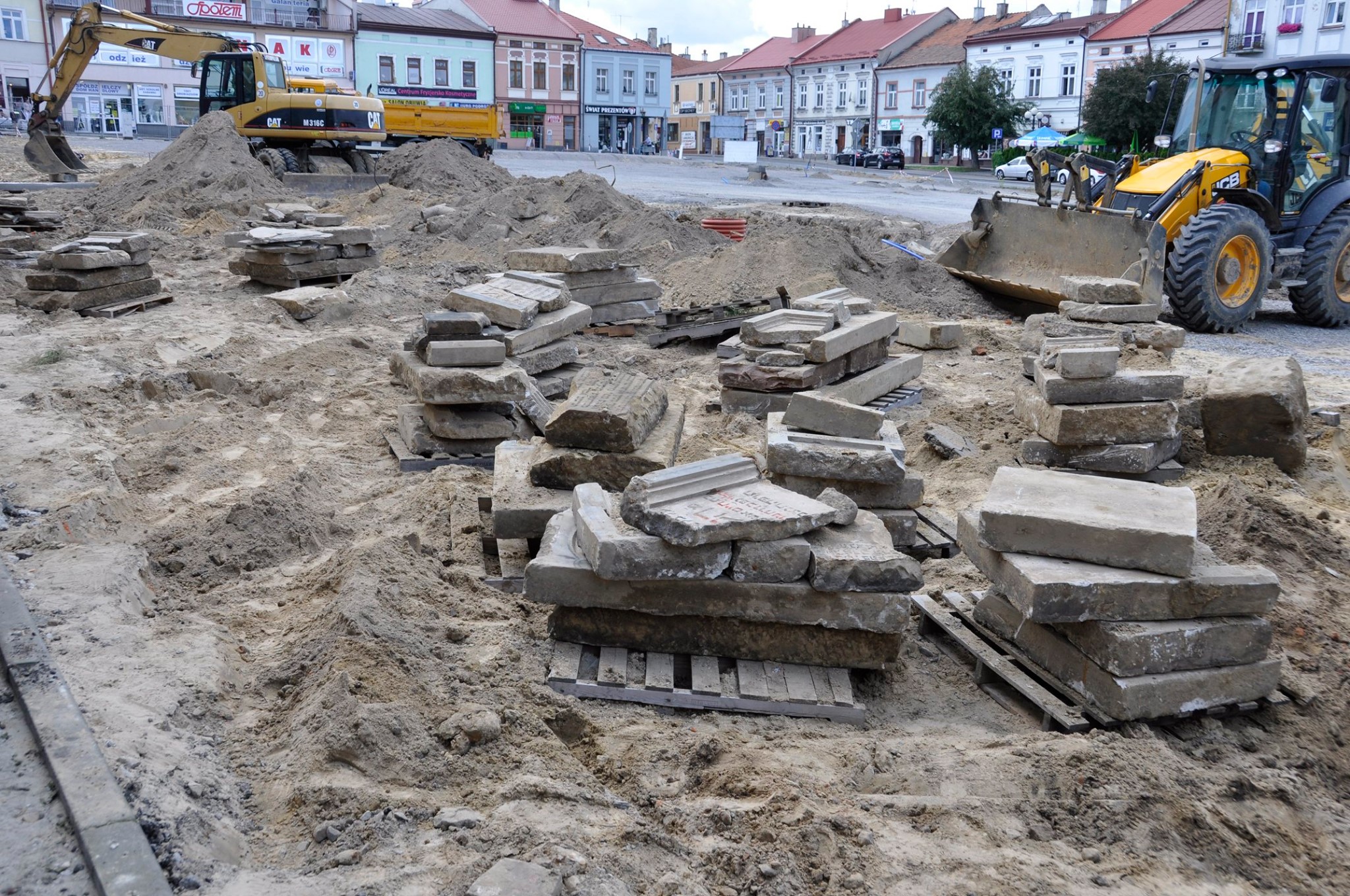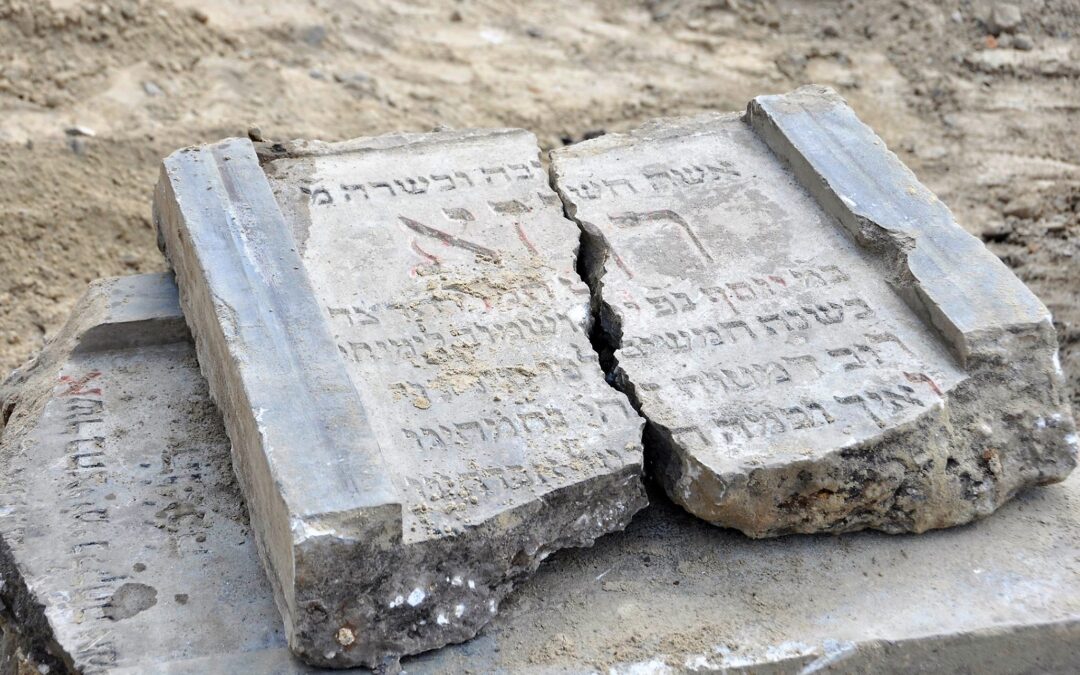Over 150 historic Jewish tombstones have been unearthed during construction in the market square of Leżajsk. It is the largest such discovery in Poland for many years.
Before the Holocaust, the Polish town had a large Jewish population and became an important site for Hasidic Judaism. During and after the war, with Jews expelled, ghettoised or murdered, gravestones were taken from the Jewish cemetery to be used in construction.
Those now discovered under the square were used by the German occupiers when laying a road. They have been gradually uncovered over recent weeks, after renovation works began in early June, reports Gazeta Wyborcza.
The tombstones had been buried below a layer of sand, brick and asphalt along a 30-metre stretch of road. As a result, many have been better conserved than the surviving tombstones at the local Jewish cemetery, with lively colours and relief ornaments.

Almost one hundred of the matzevot are mostly in tact, often with just their curved tops hewn off to allow for tighter placement side-by-side. Another fifty had been cut into smaller pieces and spread out. It is likely that more will be discovered.
“No one had expected such a number. There are over 150 and not all of them have yet been removed,” Ewa Kędzierska, an archaeologist overseeing the works, told Gazeta Wyborcza.
In the interwar period, Leżajsk’s Jews made up around one third of the town’s population, numbering between 1,500 and 2,000. Previously, in the nineteenth century, the Jewish community had been even larger. During the war, Jew were expelled or murdered, with only 33 returning afterwards.
Leżajsk also became a major centre for the Hasidism that emerged in the 18th century. One of the movement’s most important early figures was Rabbi Elimelech Weisblum of Lizhensk (the Yiddish name for Leżajsk).
To this day, thousands of Hasidic Jews undertake an annual pilgrimage to his grave in the town, and Kędzierska speculates that one of the tombstones – which features golden inscriptions in Yiddish – could have belonged to the rabbi.
“I hope this one could come from the grave of Rabbi Elimelech Weisblum of Lizhensk,” says Kędzierska. “That would be a great discovery.”
Last year, 16,000 Jews undertook the pilgrimage to Leżajsk, reports Gazeta Wyborcza. This year, over 20,000 were expected before the coronavirus prevented travel.
An estimated 6,000 Jews from around the world are visiting the Polish town of Leżajsk to pray at the tomb of Rabbi Elimelech Weisblum, one of the founders of the Hasidic movement, on the 231st anniversary of his death pic.twitter.com/NqhVy718uF
— Notes from Poland 🇵🇱 (@notesfrompoland) March 8, 2018
The age and ownership of the gravestones is yet to be determined, as they await further research and translation of the Yiddish inscriptions, says Kędzierska.
From 1940-41, the German occupiers paved the market using bricks from the town’s demolished synagogue and two bombed-out buildings. When they ran out of material, they began using gravestones from the Jewish cemetery, reports Gazeta Wyborcza.
During the recent renovation work, an elderly man approached the archaeologists and said that “he remembered when the matzevot were brought to the market in carts”, Kędzierska told the newspaper.
She also noted that it was not only the Germans that used Jewish tombstones for construction, but also local Polish residents, both during and after the war.
KOLEJNE MACEWY ZOSTAŁY ZABEZPIECZONE I KOLEJNY BRUK ODKRYTYW ubiegłym tygodniu wydobyto spod asfaltu, zinwentaryzowano…
Opublikowany przez Ireneusz Stefański – Burmistrz Leżajska Sobota, 25 lipca 2020
The town’s authorities have for now secured and stored the unearthed tombstones, and a decision on what to do with them next will be taken in consultation with Jewish religious authorities.
Filip Szczepański from the Rabbinical Commission for Cemeteries, which operates under the authority of the chief rabbi of Poland, tells Gazeta Wyborcza that, according to Jewish tradition, tombstones belong to the deceased, and therefore should not be placed in a museum.
“It is best if they return to the Jewish cemetery they come from,” says Szczepański.
Image credits: Ireneusz Stefański – Burmistrz Leżajska/Facebook

Maria Wilczek is deputy editor of Notes from Poland. She is a regular writer for The Times, The Economist and Al Jazeera English, and has also featured in Foreign Policy, Politico Europe, The Spectator and Gazeta Wyborcza.



















